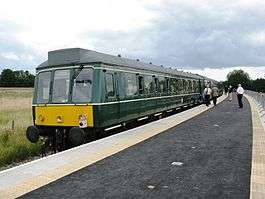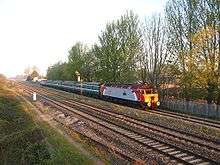Norton Fitzwarren railway station
Norton Fitzwarren railway station is an untimetabled station on the West Somerset Railway in Somerset, England. It was built in 2009 about 1⁄4 mile (0.4 km) north of the site of the old (Norton Fitzwarren) station that served the village of Norton Fitzwarren from 1873 until 1961. There were fatal railway accidents in the vicinity in 1890, 1940 and 1978.
| Norton Fitzwarren | |
|---|---|
 | |
| Location | |
| Place | Norton Fitzwarren |
| Area | Somerset West and Taunton, Somerset |
| Coordinates | 51.0246°N 3.1571°W |
| Grid reference | ST190258 |
| Operations | |
| Original company | Bristol and Exeter Railway |
| Post-grouping | Great Western Railway |
| Operated by | West Somerset Railway |
| Platforms | 2 |
| History | |
| 1873 | First station opened |
| 1961 | First station closed |
| 2009 | New station opened |
| Stations on heritage railways in the United Kingdom | |
| A B C D E F G H I J K L M N O P Q R S T U V W X Y Z | |
History
First station

The Bristol and Exeter Railway (B&ER) was opened through Norton Fitzwarren on 1 May 1843, but the nearest station was 2 miles (3 km) east at Taunton. On 31 March 1862 the original West Somerset Railway was opened to Watchet, leaving the Exeter line at Norton Junction, but still no station was provided. The first section of the Devon and Somerset Railway to Wiveliscombe opened on 8 June 1871, making a connection into the West Somerset line just west of the junction with the Exeter line.[1][2]
The first two-platform station was finally opened at the junction on 1 June 1873, located immediately east of the junction (at 51°01′24″N 3°08′57″W). On the northern platform side closest to the village was a small station building, a hotel and the goods yard.[3] Both the branch lines were operated by the B&ER until 1 January 1876 when it was amalgamated with the Great Western Railway.[1][2]
In 1931 the GWR started a project to quadruple the track between Cogload Junction (where the mainline from Bristol Temple Meads and the north met the Castle Cary cut-off line from Yeovil, Reading and London Paddington), for the 7 miles (11 km) south through Taunton to Norton Fitzwarren. The existing station buildings were demolished, to allow a new up-relief line to be built north of the existing northern platform, followed by the creation of a down relief road south of the southern platform. A new metal passenger bridge was erected, connecting the new station buildings to the north with both island platforms. The completion of the project also allowed the GWR to create the large regional goods facility at Fairwater Yard, located just east of the station. The whole project was brought into operation on 2 December 1931.[2][3]
World War 2: US Army Depot G-50
At the start of World War II, the Royal Army Service Corps choose the relatively large scale station serving the small community as the ideal location for a new logistics depot. Finished at the end of 1941, it was immediately taken over by the United States Army as part of Operation Bolero in early 1942, one of their 18 supplies depots within the United Kingdom. Redesignated Quartermaster General Depot G-50, they equipped it with extensive railway sidings to the northeast of the railway station.[4]
Part of the reasoning behind the choice of the depot, was that it was one of five within the 18 designated as a US Army Medical Corps supplies depot. Medical supplies were allocated 110,680 square feet (10,283 m2) of under cover storage, and a further 25,000 square feet (2,300 m2) outside.[5] The US Army also locally developed the 67th General Hospital at Musgrove Park. Both facilities under the control of the US Army Medical Corps came into operation on 1 September 1942.[6][7]
Closure
On 1 January 1948 the railways were nationalised and Norton Fitzwarren became a part of the Western Region of British Railways. Passenger traffic was withdrawn on 30 October 1961,[2] after which passengers for the two branches once again had to change trains at Taunton until these routes were closed on 3 October 1966 (the Devon and Somerset line) and 4 January 1971 (West Somerset line).[3] The goods yard continued to operate until 6 July 1964, when the logistics facilities of Norton Manor Camp closed.[2]
The goods facilities had always handled a large volume of locally grown cider apples, and on 1 March 1983 a private siding utilising much of the former up-relief road connection to the WSR was opened into the Taunton Cider Company’s factory on the northwest side of the former station site.[2][8] Although this factory has since closed,[3] it was this private siding that allowed the West Somerset Railway, in its new heritage railway guise, to be connected to the national railway network.[2][9]
| Preceding station | Historical railways | Following station | ||
|---|---|---|---|---|
| Wellington | Great Western Railway Bristol to Exeter |
Taunton | ||
| Bishops Lydeard | Great Western Railway Taunton to Minehead |
|||
| Milverton | Great Western Railway Taunton to Barnstaple |
|||
West Somerset Railway
In 2004 the West Somerset Railway Association (WSRA) (the volunteer organisation that supports the WSR) purchased 33 acres (13 ha) of land west of its railway and north of the main line at Norton Fitzwarren.
This included a short length of the track bed of the dismantled Barnstaple branch line. This track bed and a new north-west chord have eventually formed a triangle where rolling stock is turned when required.[10] Part of the land is used for ballast reclamation, with waste material being delivered to the site by Network Rail in conjunction with their track renewals depot at nearby Fairwater Yard.[11]
There is also sufficient space to allow for the construction of a locomotive and rolling stock restoration depot in the future.[10]
The WSRA built a single concrete platform on the west side of the Minehead to Taunton line in 2009. This is not shown in the regular timetable but is for use during special events when a shuttle service can bring people from Bishops Lydeard. It is long enough to handle four-coach trains.[12] It was first used on 1 and 2 August 2009 in association with a vintage vehicle rally on the WSR’s land at Norton Fitzwarren.[13]
There is no public access to the site currently, however it is hoped this will change in the future as the adjacent 'Ford Farm' site has been identified as a Potential Mixed Use Development site in the Taunton Deane Core Strategy[14] with an associated transport policy statement that any such development should include improved access to the adjoining West Somerset Railway station.[15]
The WSR entered into a partnership with the modern Great Western Railway (GWR) in 2019 to operate Summer Saturday services between Taunton and Bishops Lydeard on Saturdays when special events are taking place. On 3 August, services will call additionally at Norton Fitzwarren for the annual Steam Fayre Vintage Rally, run by the WSRA, taking place at the station.[16][17] The introduction of these GWR services will be the first time the new station has been served by a train from the national rail network.
| Preceding station | Following station | |||
|---|---|---|---|---|
| Taunton | Great Western Railway Special services only |
Bishops Lydeard | ||
| Bishops Lydeard | West Somerset Railway Special services only |
Terminus | ||
Accidents
Three significant accidents have happened on the main line in the vicinity of Norton Fitzwarren:
- The Ocean Mails collision – 4-4-0ST No. 2051 was withdrawn following a fatal collision at Norton Fitzwarren on 11 November 1890 while working a special Travelling Post Office conveying mail from a trans-Atlantic liner which had been landed at Plymouth Millbay.[18]
- The wartime collision – another crash occurred on 4 November 1940, which left 27 people dead,[19] this time when a driver of a train leaving Taunton under blackout conditions due to the war misread signals and believed he was on a different line to the one on which he was travelling. The train was derailed at trap points as the driver mistook main line signals for his own.
- The Taunton sleeper fire – a coach in the 22:30 sleeper train from Penzance to London Paddington station caught fire on the morning of 6 July 1978 and was brought to a stand near Norton Fitzwarren. Twelve people were killed and 15 people were injured.[20]
References
- MacDermot, E T (1931). History of the Great Western Railway. 2 (1863-1921) (1 ed.). London: Great Western Railway.
- Vic Mitchell & Keith Smith (July 1990). Branchline to Minehead. Middleton Press. ISBN 9780906520802.
- Oakley, Mike (2006). Somerset Railway Stations. Bristol: Redcliffe Press. ISBN 1-904537-54-5.
- "The New Somerset Heritage Centre and its Site History". Somerset County Council. Retrieved 15 August 2012.
- US Army Medical Department. "CHAPTER IX Europe: Preinvasion Buildup in the United Kingdom". Retrieved 15 August 2012.
- "History in Brief". Musgrove Park Hospital. Retrieved 5 July 2009.
- Wakefield, Ken (1994). Operation Bolero: The Americans in Bristol and the West Country 1942-45. Crecy Books. p. 101. ISBN 0-947554-51-3.
- Maggs, Colin G (1991). Taunton Steam. Bath: Millstream Books. ISBN 0-948975-26-1.
- Jacobs, Gerald (2005). Railway Track Diagrams Book 3: Western. Bradford-on-Avon: Trackmaps. ISBN 0-9549866-1-X.
- "The Norton Fitzwarren Project". West Somerset Railway Association. Archived from the original on 8 July 2009. Retrieved 6 August 2009.
- "Norton Fitzwarren Report 28 November 2006". West Somerset Railway Association. Archived from the original on 23 October 2008. Retrieved 6 August 2009.
- "A station for Norton Fitzwarren". West Somerset Railway Association. Archived from the original on 8 July 2009. Retrieved 6 August 2009.
- "The Steam Fayre and Vintage Rally". West Somerset Railway Association. Archived from the original on 29 July 2009. Retrieved 31 July 2009.
- "Taunton Deane Core Strategic Diagram, Norton Fitzwarren" (PDF). Retrieved 14 August 2017.
- "Taunton Deane Core Strategy Transport Statement". paragraph 3.86, final sentence. Retrieved 14 August 2017.
- "New Somerset train services start on July 27 GWR Shuttles to West Somerset Railway details announced". West Somerset Railway. 8 July 2019. Retrieved 10 July 2019.
- "Steam Fayre Vintage Rally". West Somerset Railway. Retrieved 11 July 2019.
- Rich, Colonel F. H. (15 November 1890). "Report of the Board of Trade Enquiry" (PDF).
- "Report to the Ministry of Transport" (PDF). Great Western Railway. 7 December 1940. Retrieved 7 August 2009. Cite journal requires
|journal=(help) - Department of Transport; King, Major A.G.B. (1980). Railway Accident: Report on the Fire that occurred in a Sleeping-Car Train on 6th July 1978 at Taunton in the Western Region, British Railways. HMSO. ISBN 0-11-550513-X.